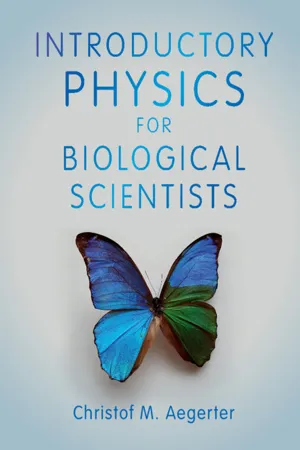
- English
- PDF
- Available on iOS & Android
Introductory Physics for Biological Scientists
About this book
Why do elephants have sturdier thigh bones than humans? Why can't ostriches fly? How do bacteria swim through fluids? With each chapter structured around relevant biological case studies and examples, this engaging, full-colour book introduces fundamental physical concepts essential in the study of biological phenomena. Optics is introduced within the context of butterfly wing colouration, electricity is explained through the propagation of nerve signals, and accelerated motion is conveniently illustrated using the example of the jumping armadillo. Other key physical concepts covered include waves, mechanical forces, thermodynamics and magnetism, and important biological techniques are also discussed within this context, such as gel electrophoresis and fluorescence microscopy. A detailed appendix provides further discussion of the mathematical concepts utilised within the book, and numerous exercises and quizzes allow readers to test their understanding of key concepts. This book is invaluable to students aiming to improve their quantitative and analytical skills and understand the deeper nature of biological phenomena.
Frequently asked questions
- Essential is ideal for learners and professionals who enjoy exploring a wide range of subjects. Access the Essential Library with 800,000+ trusted titles and best-sellers across business, personal growth, and the humanities. Includes unlimited reading time and Standard Read Aloud voice.
- Complete: Perfect for advanced learners and researchers needing full, unrestricted access. Unlock 1.4M+ books across hundreds of subjects, including academic and specialized titles. The Complete Plan also includes advanced features like Premium Read Aloud and Research Assistant.
Please note we cannot support devices running on iOS 13 and Android 7 or earlier. Learn more about using the app.
Information
Table of contents
- Cover
- Half-title
- Title page
- Copyright information
- Contents
- Preface: How to Use This Book
- 1 Physics as a Basis for Describing Biological Systems
- 2 Errors, Units, and Scaling Laws
- 3 Motions and Oscillations
- 4 Resonances and Waves
- 5 Optics, Light, and Colors
- 6 Forces and Newton’s Laws of Motion
- 7 Continuum Mechanics
- 8 Heat, Temperature, and Entropy
- 9 Electrical Charges and Currents
- 10 Magnetism
- Appendix A Mathematical Tools
- Appendix B Solutions to Quizzes
- References
- Index